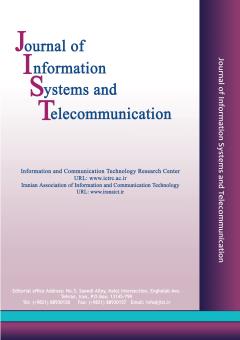Cache Point Selection and Transmissions Reduction using LSTM Neural Network
الموضوعات : Wireless NetworkMalihe Bahekmat 1 , Mohammad Hossein Yaghmaee Moghaddam 2
1 - Department of Computer Engineering, Ferdowsi University of Mashhad, Iran
2 - Department of Computer Engineering, Ferdowsi University of Mashhad, Iran
الکلمات المفتاحية: Reliability, Selection of Cache Points, Middle caching, Wireless Sensor Networks,
ملخص المقالة :
Reliability of data transmission in wireless sensor networks (WSN) is very important in the case of high lost packet rate due to link problems or buffer congestion. In this regard, mechanisms such as middle cache points and congestion control can improve the performance of the reliability of transmission protocols when the packet is lost. On the other hand, the issue of energy consumption in this type of networks has become an important parameter in their reliability. In this paper, considering the energy constraints in the sensor nodes and the direct relationship between energy consumption and the number of transmissions made by the nodes, the system tries to reduce the number of transmissions needed to send a packet from source to destination as much as possible by optimal selection of the cache points and packet caching. In order to select the best cache points, the information extracted from the network behavior analysis by deep learning algorithm has been used. In the training phase, long-short term memory (LSTM) capabilities as an example of recurrent neural network (RNN) deep learning networks to learn network conditions. The results show that the proposed method works better in examining the evaluation criteria of transmission costs, end-to-end delays, cache use and throughput.
[1]. A. Khalifeh et al., “Wireless sensor networks for smart cities: Network design, implementation and performance evaluation, Electron” vol. 10, no. 2, pp. 1–28, 2021, doi: 10.3390/electronics10020218.
[2]. A. Shankar, N. R. Sivakumar, M. Sivaram, A. Ambikapathy, T. K. Nguyen, and V. Dhasarathan, “Increasing fault tolerance ability and network lifetime with clustered pollination in wireless sensor networks,” J. Ambient Intell. Humaniz. Comput., vol. 12, no. 2, pp. 2285–2298, 2021, doi: 10.1007/s12652-020-02325-z.
[3]. Kabashkin, I., Reliability of Cluster-Based Nodes in Wireless Sensor Networks of Cyber Physical Systems. Procedia Computer Science, 2019. 151: p. 313-320.
[4]. W. Osamy, A. A. El-Sawy, and A. Salim, “CSOCA: Chicken Swarm Optimization Based Clustering Algorithm for Wireless Sensor Networks,” IEEE Access, vol. 8, pp. 60676–60688, 2020, doi: 10.1109/ACCESS.2020.2983483.
[5]. S. K. S. L. Preeth, R. Dhanalakshmi, and P. M. Shakeel, “An intelligent approach for energy efficient trajectory design for mobile sink based IoT supported wireless sensor networks,” Peer-to-Peer Netw. Appl., vol. 13, no. 6, pp. 2011–2022, 2020, doi: 10.1007/s12083-019-00798-0.
[6]. Zhou, Y., et al., Topology design and cross-layer optimization for wireless body sensor networks. Ad Hoc Networks, 2017. 59: p. 48-62.
[7]. R. Arya and S. C. Sharma, “Analysis and optimization of energy of Sensor node using ACO in wireless sensor network,” Procedia Comput. Sci., vol. 45, no. C, pp. 681–686, 2015, doi: 10.1016/j.procs.2015.03.132.
[8]. Singh, A., Sharma, S. and Singh, J., 2021. Nature-inspired algorithms for wireless sensor networks: A comprehensive survey. Computer Science Review, 39, p.100342.
[9]. A. Singh, S. Sharma, and J. Singh, “Nature-inspired algorithms for Wireless Sensor Networks: A comprehensive survey,” Comput. Sci. Rev., vol. 39, 2021, doi: 10.1016/j.cosrev.2020.100342.
[10]. H. Zhong, L. Shao, J. Cui, and Y. Xu, “An efficient and secure recoverable data aggregation scheme for heterogeneous wireless sensor networks,” J. Parallel Distrib. Comput., vol. 111, pp. 1–12, 2018, doi: 10.1016/j.jpdc.2017.06.019.
[11]. N. Abbas and F. Yu, “Design and Implementation of a Video Surveillance System for Linear Wireless Multimedia Sensor Networks,” 2018 3rd IEEE Int. Conf. Image, Vis. Comput. ICIVC 2018, pp. 524–527, 2018, doi: 10.1109/ICIVC.2018.8492776.
[12]. M. Mohamed-Lamine, “New clustering scheme for wireless sensor networks,” 2013 8th Int. Work. Syst. Signal Process. Their Appl. WoSSPA 2013, pp. 487–491, 2013, doi: 10.1109/WoSSPA.2013.6602412.
[13]. Meenakshi, D. and Kumar, S., 2012. "Energy Efficient Hierarchical Clustering Routing Protocol for Wireless Sensor Networks". Springer, pp. 409-420.
[14]. N. Goel and G. Aujl, “Simulation and feasibility analysis: Hierarchical Energy Efficient Routing Protocol (HEERP) for Wireless Sensor Network,” Int. Conf. Commun. Signal Process. ICCSP 2013 - Proc., pp. 1143–1148, 2013, doi: 10.1109/iccsp.2013.6577235.
[15]. T. Ducrocq, N. Mitton, and M. Hauspie, “Energy-based clustering for wireless sensor network lifetime optimization,” IEEE Wirel. Commun. Netw. Conf. WCNC, pp. 968–973, 2013, doi: 10.1109/WCNC.2013.6554695.
[16]. R. Mhemed, N. Aslam, W. Phillips, and F. Comeau, “An energy efficient fuzzy logic cluster formation protocol in wireless sensor networks,” Procedia Comput. Sci., vol. 10, pp. 255–262, 2012, doi: 10.1016/j.procs.2012.06.035.
[17]. P. Zhang, G. Xiao, and H. P. Tan, “Clustering algorithms for maximizing the lifetime of wireless sensor networks with energy-harvesting sensors,” Comput. Networks, vol. 57, no. 14, pp. 2689–2704, 2013, doi: 10.1016/j.comnet.2013.06.003.
[18]. Y. Shen and X. Li, “Wavelet neural network approach for dynamic power management in wireless sensor networks,” Proc. Int. Conf. Embed. Softw. Syst. ICESS 2008, pp. 376–381, 2008, doi: 10.1109/ICESS.2008.36.
[19]. Oldewurtel F and Mahonen P. (2006) 'Neural Wireless Sensor Networks', In: International Conference on Systems and Networks Communications, ICSNC '06.
[20]. L. Chou, D. C. Li, and W. Hong, "Improving energy‐efficient communications with a battery lifetime‐aware mechanism in IEEE802. 16e wireless networks," Concurr. Comput. Pract. Exp., vol. 25, no. 1, pp. 94–111, 2013.
[21]. P. Mohanty and M. R. Kabat, “A hierarchical energy efficient reliable transport protocol for wireless sensor networks,” Ain Shams Eng. J., vol. 5, no. 4, pp. 1141–1155, 2014, doi: 10.1016/j.asej.2014.05.009.
[22]. B. Sharma and T. C. Aseri, “A hybrid and dynamic reliable transport protocol for wireless sensor networks,” Comput. Electr. Eng., vol. 48, pp. 298–311, 2015, doi: 10.1016/j.compeleceng.2015.01.007.
[23]. Tiglao, N.M.C. and A.M. Grilo. Transmission Window Optimization for Caching-Based Transport Protocols in Wireless Sensor Networks. 2015. Cham: Springer International Publishing.
[24]. Alipio, M.I. and N.M.C. Tiglao, RT-CaCC: A Reliable Transport With Cache-Aware Congestion Control Protocol in Wireless Sensor Networks. IEEE Transactions on Wireless Communications, 2018. 17(7): p. 4607-4619.


